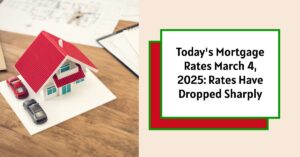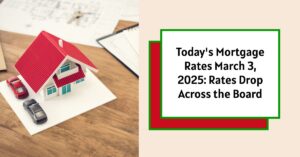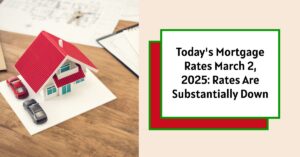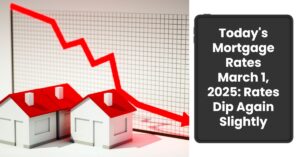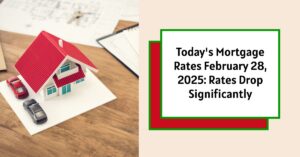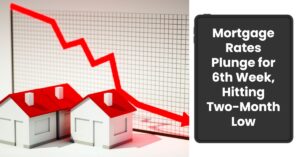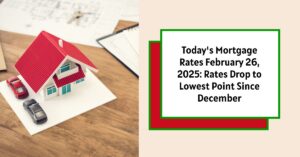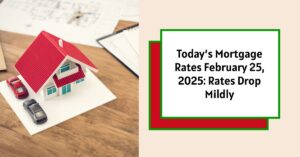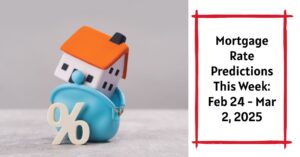Today's mortgage rates on March 4, 2025, show a slight decrease, particularly in the 30-year fixed mortgage rate, which sits at an average of 6.26%. However, mortgage rates have dropped nearly 30 basis points from their February average and plunged last week amid market fears of an economic slowdown.
It signifies a potentially more favorable environment for entering the housing market or adjusting your current mortgage terms. I know that even a small drop can feel like a big win when you're dealing with such significant financial decisions. Let's dive into the details to understand what this means for you.
Today's Mortgage Rates March 4, 2025: Rates Have Dropped Sharply
Navigating the world of mortgages can feel like deciphering a complex code. There are so many different types of loans, lenders, and economic factors that play a role. Let's break down exactly what the mortgage rates look like right now.
Snapshot of Today's Mortgage Rates (March 4, 2025)
According to data from Zillow, here's a quick overview of the current mortgage rate averages:
| Mortgage Type | Average Rate Today |
|---|---|
| 30-Year Fixed | 6.26% |
| 20-Year Fixed | 5.94% |
| 15-Year Fixed | 5.58% |
| 5/1 ARM | 6.15% |
| 7/1 ARM | 6.21% |
| 30-Year VA | 5.72% |
| 15-Year VA | 5.24% |
| 5/1 VA | 5.89% |
A Closer Look at Refinance Rates
If you're already a homeowner and considering refinancing, it's essential to know how those rates compare. Generally, refinance rates can differ from those for new purchases. Here’s a look at the latest refinance rates:
| Refinance Type | Average Rate Today |
|---|---|
| 30-Year Fixed Refinance | 6.30% |
| 20-Year Fixed Refinance | 5.92% |
| 15-Year Fixed Refinance | 5.59% |
| 5/1 ARM Refinance | 6.24% |
| 7/1 ARM Refinance | 6.55% |
| 30-Year VA Refinance | 5.73% |
| 15-Year VA Refinance | 5.43% |
| 30-Year FHA Refinance | 5.96% |
| 15-Year FHA Refinance | 5.24% |
You'll notice that refinance rates are often a touch higher than purchase rates. This reflects the perceived risk involved in refinancing an existing loan versus originating a new one.
Why Did Rates Drop (Even Slightly)? Understanding the “Why”
Okay, so rates dipped a tiny bit. But what's really behind this change? It's never just a random occurrence; several economic factors are always at play.
- The Federal Reserve (The Fed): The Fed's decisions on interest rates have a huge impact. When the Fed lowers the federal funds rate, it can lead to lower mortgage rates. The market is constantly watching the Fed for clues about future rate adjustments. As of right now, the expectation is that interest rate cuts may not happen before the end of the year 2025.
- Economic Growth (or Lack Thereof): If the economy is slowing down, investors often shift their money into safer investments like mortgage-backed securities. This increased demand can then push mortgage rates down.
- Inflation: Inflation is a big one. If inflation is high, the Fed is more likely to keep interest rates high to try and cool down the economy. Conversely, if inflation is low, the Fed might lower rates to stimulate growth.
- Global Events: Believe it or not, events happening across the globe can impact U.S. mortgage rates. Global economic uncertainty can lead to investors seeking the safety of U.S. markets, affecting rates.
I've been following these trends for years, and I can tell you that predicting the future is impossible. However, understanding these driving forces allows you to make informed guesses and react strategically.
How Current Rates Impact Your Monthly Payments
Let's get down to brass tacks: how do today's rates translate into your monthly mortgage payments? While 6.26% for a 30-year fixed mortgage is the average, I know a lot of potential homebuyers are trying to figure out how much they're going to pay per month. Here's a breakdown of estimated monthly payments for different loan amounts:
| Mortgage Amount | Estimated Monthly Payment (at 6.26%) |
|---|---|
| $150,000 | $925.43 |
| $200,000 | $1,233.91 |
| $300,000 | $1,850.39 |
| $400,000 | $2,466.87 |
| $500,000 | $3,083.35 |
Important Note: These are just estimates and don't include property taxes, homeowner's insurance, or any potential HOA fees. Make sure to factor those in to get a complete picture of your total monthly housing costs. I can't stress this enough: budget conservatively! It's better to underestimate than to overestimate your spending.
More Than Just the Numbers: Choosing the Right Mortgage For You
The lowest interest rate isn't always the best option. It depends on your individual financial situation and goals.
- 30-Year Fixed: This is the most popular option for a reason. It offers a stable, predictable monthly payment over the life of the loan. This is a good choice for those who prioritize stability and long-term affordability.
- 15-Year Fixed: You'll pay it off faster and pay significantly less interest over the life of the loan. But the monthly payments will be higher.
- Adjustable-Rate Mortgages (ARMs): These typically offer a lower initial interest rate than fixed-rate mortgages, but the rate can adjust periodically based on market conditions. ARMs can be attractive in the short term, but the uncertainty of future rate adjustments should give you pause. ARMs can be risky.
- VA Loans: For eligible veterans, VA loans offer great benefits, including no down payment and often lower interest rates.
- FHA Loans: FHA loans are insured by the Federal Housing Administration and are designed for borrowers with lower credit scores or smaller down payments.
My Personal Tip: Don't just jump at the lowest rate you see advertised. Consider the long-term implications of each loan type and how it fits into your overall financial plan.
Factors That Affect Your Mortgage Rate (It's Personal!)
While general market conditions influence mortgage rates, your individual rate is determined by several personal financial factors.
- Credit Score: A higher credit score (typically 740 or above) will get you the best rates. Make sure to check your credit report for any errors and take steps to improve your score if needed.
- Debt-to-Income Ratio (DTI): Lenders want to see that you have a handle on your debt. A lower DTI (the percentage of your gross monthly income that goes towards debt payments) signals that you're a less risky borrower.
- Down Payment: A larger down payment reduces the lender's risk and can result in a lower interest rate. Plus, putting down at least 20% allows you to avoid private mortgage insurance (PMI), which is an added monthly expense.
- Loan Type: As mentioned earlier, different loan types come with different interest rates and terms.
- Property Location: Believe it or not, where you're buying can affect your rate. Lenders consider local market conditions and property values.
Recommended Read:
Mortgage Rates Trends as of March 3, 2025
Mortgage Rates Forecast March 2025: Will Rates Finally Drop?
Expect High Mortgage Rates Until 2026: Fannie Mae's 2-Year Forecast
Shopping Around: Your Secret Weapon
I cannot emphasize this enough: shop around! Don't settle for the first offer you receive.
- Get Multiple Quotes: Contact at least three different lenders – banks, credit unions, mortgage brokers – and compare their rates and fees.
- Look Beyond the Interest Rate: Pay attention to closing costs, points (fees paid upfront to lower your interest rate), and other fees.
- Consider a Mortgage Broker: A mortgage broker can shop around for you and find the best rates and terms from multiple lenders.
- Don't Be Afraid to Negotiate: Once you have multiple offers, use them to negotiate with lenders.
Remember, even a small difference in interest rates can save you thousands of dollars over the life of the loan.
What's On The Horizon? Looking Ahead
So, what can we expect in the coming months?
While that slight decrease in mortgage rates is positive news, experts predict that significant drops in rates may not happen before the end of 2025. Any potential decrease will largely depend on the economic environment and actions taken by the Federal Reserve.
My advice? Stay informed. Keep an eye on economic news and forecasts. Talk to a qualified financial advisor who can help you assess your individual situation and make informed decisions. Don't let fear or uncertainty paralyze you. Knowledge is power, and in the world of mortgages, it can save you a lot of money.
Remember, buying a home or refinancing your mortgage is a big decision. Take your time, do your research, and choose the option that's right for you.
Work with Norada in 2025, Your Trusted Source for
Real Estate Investing
With mortgage rates fluctuating, investing in turnkey real estate
can help you secure consistent returns.
Expand your portfolio confidently, even in a shifting interest rate environment.
Speak with our expert investment counselors (No Obligation):
(800) 611-3060
Recommended Read:
- Mortgage Rates Forecast for the Next 3 Years: 2025 to 2027
- 30-Year Mortgage Rate Forecast for the Next 5 Years
- 15-Year Mortgage Rate Forecast for the Next 5 Years
- Why Are Mortgage Rates Going Up in 2025: Will Rates Drop?
- Why Are Mortgage Rates So High and Predictions for 2025
- Will Mortgage Rates Ever Be 3% Again in the Future?
- Mortgage Rates Predictions for Next 2 Years
- Mortgage Rate Predictions for Next 5 Years
- Mortgage Rate Predictions: Why 2% and 3% Rates are Out of Reach
- How Lower Mortgage Rates Can Save You Thousands?
- How to Get a Low Mortgage Interest Rate?
- Will Mortgage Rates Ever Be 4% Again?
